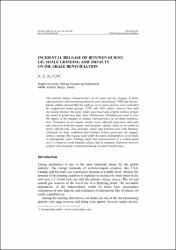INCIDENTAL RELEASE OF BITUMEN DURING OIL SHALE GRINDING AND IMPACTS ON OIL SHALE BENEFICIATION
Özet
The particle surface characteristics of oil shale and the changes in these characteristics with increasing fineness were determined. FTIR and electro-kinetic studies showed that the surfaces of oil shale particle were controlled by oxygen-rich polar groups. FTIR and XPS studies showed that with increasing fineness the polar oxides decreased and organic surface groups increased at grind sizes finer than 100 microns. Flotation was used to view the impact of the changes in surface characteristics on oil shale beneficiation. Formation of an organic surface layer affected separation adversely and selectivity between organic and inorganic entities could not be achieved below 100 microns. Zeta potential values and flotation tests with bitumen-extracted oil shale confirmed that bitumen release generates the organic surface coating. The organic layer shifts the native hydrophilicity of oil shale to hydrophobic state. Findings imply that determination of a certain grind size is critical to avoid bitumen release and to maintain selectivity between organic and inorganic constituents during oil shale beneficiation.


















